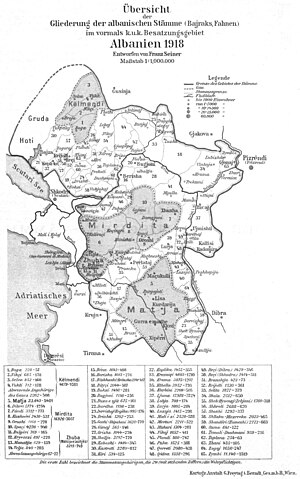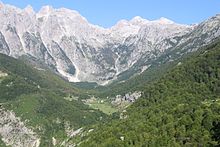Nikaj-Mërtur Contents Geography Administrative division Anthropology Demographics Notable people See...
ButrintDajtDivjakë-KaravastaFir of DrenovëFir of Hotovë-DangelliLlogaraLurë-Dejës MtPrespëShebenik-JabllanicëShtamë PassThethTomorrValbonë ValleyKaraburun SazanAmantiaAntigoneaApolloniaByllisLissusOricumPhoeniceShkodër
Tribes of AlbaniaTropojëHistorical regions in AlbaniaAlbanian ethnographic regions
AlbaniaAlbanian tribeAlbanian AlpsDukagjin highlandsTropojë DistrictGjakovaKrasniqi tribeBerishaMaja e HekuraveMaja e KakisëMaja e NdërmanjësQafa e KolcitGjakovaQafa e NdërmajësShala tribeAlpine climateClivestocklimestonedolomiteschistDrin riverLekbibajFierzëBujanThethShalëShoshFierzë, PukëFierzë, Tropojëkm2Krasniqi tribeVajushShkodraGusinjeEdith DurhamBerisha tribeShalaShoshiDushmanitribal law of Lek DukagjinBlood feudsKanun rulesCatholicSlavic
Coordinates: 42°18′29.1″N 19°54′14.7″E / 42.308083°N 19.904083°E / 42.308083; 19.904083
| Nikaj-Mërtur | |
|---|---|
 Albanian bajraks (1918). Nikaj is numbered 44, Mërturi is number 42. | |
| Current region | Northern Albania |
Nikaj-Mërtur is a region of Northern Albania whose territory is synonymous with the historic Albanian tribe of the same name.[1] The region of Nikaj-Mërtur is located in the south-east of the Albanian Alps, bordering Dukagjin highlands within Tropojë District. It is a southern extension of the Gjakova highland.[2] Nikaj is considered having derived from Krasniqi tribe, while Mërtur is direct blood and relative to the Berisha.[3] In 2014, the region was proclaimed as the Nikaj-Mertur Regional Nature Park.[4]
Contents
1 Geography
1.1 Geology
1.2 Hydrology
2 Administrative division
3 Anthropology
3.1 Nikaj
3.2 Mërturi
4 Demographics
5 Notable people
6 See also
7 Further reading
8 External links
9 External links
10 References
Geography
The Alps' mountain peaks surrounding the area are: Maja e Hekurave, "Grykat e Hapta" (English: Open gorges), Maja e Kakisë, Maja e Ndërmanjës. "Qafa e Kolcit" connects the area to the Krasniqi tribe of the Gjakova highlands, while "Qafa e Ndërmajës" connect it to the Shala tribe and "Qafa e Agrit" (1300m) connects it to the Dukagjin region. It has Alpine climate with a robust winter season, plenty of snowfall and relatively cool summer. Average year-long temperature is 11.5 C, and snow reaches 2570 mm/year. Oak, beech, and pine are predominant in the flora. The climate and terrain favor livestock. There is a great potential for mountain tourism.
Geology
The geological composition of the terrain consists of limestone, dolomite, and schist.

Lekbibaj region, Tropoje
Hydrology
Nikaj-Mërtur is a valley traspased by two rives that bear the clans names: "Lumi i Nikajve" (English: Nikaj river) and "Lumi i Mërturit" (English: Mërtur river). Nikaj river starts in Ndërmanjë valley as "Lumi i Zi" (English: Black river), passes through Kapit, Gjonpepaj, and Lekbibaj villages and joins Mërtur river south-west of Curraj i Poshtëm village. Mërturi river itself starts in Curraj i Epërm village, passes along "Mali i Theposur " (English: Sharp mountain) between the villages Shëngjergj and Curraj i Poshtëm, and after joining Nikaj river continue through Raje and Tetaj villages, with Drin river as a final destination.[5] Both rivers are relatively short.
Administrative division
Administratively, the region falls under Lekbibaj municipality, beside the Rajë village which belongs to the Fierzë municipality. On the east it borders Bujan municipality, Theth in the north, Shalë and Shosh in the west, Fierzë, Pukë and Fierzë, Tropojë in the south. The area lays within circa 200 km2.
Anthropology
Nikaj
The name Nikaj was recorded in 1671 as Nicagni or Nichagni. The legendary ancestral father of the Nikaj tribe was a herdsman from Krasniqi tribe called Nikë Mekshi, who left Krasniqi region around 1550-1600, and settled in the area of Paplekaj i Epërm. This area was said to be the oldest part of Nikaj. Nikë Mekshi was the brother of Kolë Mekshi who is considered to have been the ancestral father of the Kolmekshaj branch of the Krasniqi tribe. For this reason, Nikaj does not intermarry with them.
In oral tradition, the Nikaj is said to have replaced an early population called Mavriqi. They were said to steem from Vajush near Shkodra and settled in the mountain of Nikaj in the period of 1416-1500. With the spread of Nikaj, most of the earlier inhabitants emigrated to Gusinje region, although some of them remained and were assimilated. This earlier population is associated, in particular, with the settlement of Kapit.[6]
Traveller Edith Durham visited North Albania in the 1900s. She collected the following information about the tribes of Dukagjin, whom she grouped into the Pulati, and then into the two groups of Lower Pulati (or Pulati proper) and those of the Diocese of Pulati. She said that Pulati was hard to define, as the ecclesiastical borders (Diocese of Pulati) extended farther than the Pulati tribes. She described the Nikaj, in the Diocese of Pulati, as:[7]
.mw-parser-output .templatequote{overflow:hidden;margin:1em 0;padding:0 40px}.mw-parser-output .templatequote .templatequotecite{line-height:1.5em;text-align:left;padding-left:1.6em;margin-top:0}
This is an offshoot of from the Moslem tribe of Krasnich (brother to Hoti). Its ancestor Nikol left Krasnich while Krasnich was yet Christian (Catholic or Orthodox ?). One hundred houses of Nikaj, the Tsuraj, trace descent from a daughter of Nikol who bore an illegitimate son by a gypsy which Nikol adopted. This is the only case of female descent I heard of. Nikaj is all Catholic. It is one of the wildest and most poverty-stricken of the tribes."[7]
Mërturi

Mërturi men photographed by Franz Nopcsa.
The name Marturi was first recorded as a toponym in 1629.[3] The legendary ancestral father of the Mërturi tribe was called Lek Poga, son of Pog Murri and grandson of Murr Detti. His brother Kol Poga, was the ancestral father of the closely related Berisha tribe. Lek Poga, had five sons who settled a various parts of Mërturi: Bib Leka in Shëngjergj, Raja and Mulaj; Ndre Leka in Palç, Apripa and Mërturi i Gurit; Mar Leka in Salca and Brisa; Tet Leka in Markaj, Tetaj and Bëtosha; and Pec Leka in Bëtosha.[8]
The Mërturi and Berisha were initially one tribe and separated in 1520.[8]
Demographics
The Nikaj tribe had a population of some 2,200 in the early years of the 20th century. They were the enemies of the Shala and Shoshi, and were considered, together with the Dushmani, to be among the wildest inhabitants of the northern mountains.[9] The tribe was known for being so warlike among other Albanian tribes that they were feared by them and the Nikaj posed a reputation of not following the tribal law of Lek Dukagjin or its elders.[10] During the late Ottoman period, the tribe of Shala was exclusively Catholic and it was a famous Albanian tribe.[11]
Nikaj-Mërtur region contains the following settlements: Lekbibaj, Gjonpepaj, Peraj, Curraj i Poshtëm, Curraj i Epërm, Qeresh, Kuq, Tetaj, Bëtoshë (Btoshë), Shëngjergj, Salcë, Palçë, Kotec, Brisë, Mulaj, Kapit, Varg (Vark), Shofrran, Paplekaj, Bushat, Mserr, Markaj, and Rajë. The first seven belong to Nikaj clan. Blood feuds and Kanun rules are present in the area.[12]
The population belong mainly to the Catholic rite, with a Muslim minority.
The area presents an interesting toponymy, being pure[dubious ] and totally uninfluenced by Slavic elements,[citation needed] i.e. "Shtegu i Dashit", "Rrasa e Currajve", "Shpella e Lumit", "Qafa e Rrethit", "Qafa e Derzave", "Shpella e Kakverrit", "Rruku i Nikajve", "Kodra Plakë", "Gurrat e Lumit të Zi", "Qafa e Murrizit", "Qafa e T'thermes", "Fusha e Shukut", "Kodra e Palçit", "Guri Murg", "Korja e Mërtuit", "Qafa e Kolcit", "Qafa e Agrit" etc.
Notable people
Asllan Curri - Albanian Revolutionary
Bajram Curri - Albanian Revolutionary
Hysni Curri - Albanian Revolutionary
Ndoc Nikaj - One of the founder of Shoqnia Bashkimi
See also
- List of Albanian tribes
Further reading
Nikaj-Mërturi: vështrim historik, Dodë Progni, Zef Doda, "Shtjefni" 2003, .mw-parser-output cite.citation{font-style:inherit}.mw-parser-output .citation q{quotes:"""""""'""'"}.mw-parser-output .citation .cs1-lock-free a{background:url("//upload.wikimedia.org/wikipedia/commons/thumb/6/65/Lock-green.svg/9px-Lock-green.svg.png")no-repeat;background-position:right .1em center}.mw-parser-output .citation .cs1-lock-limited a,.mw-parser-output .citation .cs1-lock-registration a{background:url("//upload.wikimedia.org/wikipedia/commons/thumb/d/d6/Lock-gray-alt-2.svg/9px-Lock-gray-alt-2.svg.png")no-repeat;background-position:right .1em center}.mw-parser-output .citation .cs1-lock-subscription a{background:url("//upload.wikimedia.org/wikipedia/commons/thumb/a/aa/Lock-red-alt-2.svg/9px-Lock-red-alt-2.svg.png")no-repeat;background-position:right .1em center}.mw-parser-output .cs1-subscription,.mw-parser-output .cs1-registration{color:#555}.mw-parser-output .cs1-subscription span,.mw-parser-output .cs1-registration span{border-bottom:1px dotted;cursor:help}.mw-parser-output .cs1-ws-icon a{background:url("//upload.wikimedia.org/wikipedia/commons/thumb/4/4c/Wikisource-logo.svg/12px-Wikisource-logo.svg.png")no-repeat;background-position:right .1em center}.mw-parser-output code.cs1-code{color:inherit;background:inherit;border:inherit;padding:inherit}.mw-parser-output .cs1-hidden-error{display:none;font-size:100%}.mw-parser-output .cs1-visible-error{font-size:100%}.mw-parser-output .cs1-maint{display:none;color:#33aa33;margin-left:0.3em}.mw-parser-output .cs1-subscription,.mw-parser-output .cs1-registration,.mw-parser-output .cs1-format{font-size:95%}.mw-parser-output .cs1-kern-left,.mw-parser-output .cs1-kern-wl-left{padding-left:0.2em}.mw-parser-output .cs1-kern-right,.mw-parser-output .cs1-kern-wl-right{padding-right:0.2em}
ISBN 9789992782644
External links
- Nikaj-Mërturi Region
External links
- Nikaj Merturi: la meraviglia nascosta tra le Alpi albanesi
References
^ Andromaqi Gjergji (Academy of Sciences of Albania, Institute of Folkloric Culture) (2004). Albanian Costumes Through the Centuries: Origin, Types, Evolution. Mësonjëtorja. p. 152. ISBN 9789994361441.
^ Universiteti Shtetëror i Tiranës. Instituti i Historisë e Gjuhësisë. Sektori i Etnografisë.; Instituti i Historisë (Akademia e Shkencave e RPSH). Sektori i Etnografisë (1984). Etnografia shqiptare. 13-14. Akademia e Shkencave e RPSH, Instituti i Historisë, Sektori i Etnografisë. p. 290. OCLC 2260870.
^ ab Robert Elsie (2010), Historical Dictionary of Albania, Historical Dictionaries of Europe, 75 (2 ed.), Scarecrow Press, p. 299, ISBN 978-0810861886,The Merturi region is situated north and south of the Drin River in the Districts of Puka and Tropoja, basically the area to the west of the town of Fierza. It borders on the traditional tribal regions of Shoshi to the west, Nikaj to the north and northwest, Krasniqi to the east and Berisha, with whom it is closely related...
The name was recorded in 1629 as Marturi.
^ http://www.shqiptarja.com/fotogaleri/index.php?id=14353&IDCategoria=4
^ Dayrell Oakley-Hill, David Smiley (2002). An Englishman in Albania: memoirs of a British officer 1929-1955. Centre for Albanian Studies. p. 62. ISBN 9781903616208.
^ The Tribes of Albania,:History, Society and Culture. Robert Elsie. p. 151.
^ ab Durham 1908, Pulati Group
^ ab The Tribes of Albania,:History, Society and Culture. Robert Elsie. p. 159.
^ Robert Elsie (2010), Historical Dictionary of Albania, Historical Dictionaries of Europe (75) (2 ed.), The Scarecrow Press, Inc, p. 328, ISBN 9780810861886
^ Gawrych 2006, p. 31.
^ Gawrych, George (2006). The Crescent and the Eagle: Ottoman rule, Islam and the Albanians, 1874–1913. London: IB Tauris. pp. 31-32. ISBN 9781845112875.
^ Islam Qerimi, Vjollca Salihu (2011-12-07). Social Organization and Self-Government of Albanians According to the Costumary Law. GRIN Verlag. pp. 5, 8, 19. ISBN 9783640947867....The code was applied and it is still applied in these regions: Lezha mountains, Mirditë, Shala, Shoshë and Nikaj, Mertur, also in Dukagjin areain the west part of the Republic of Kosovo. This code was summarized and codified in the end of XIX...
